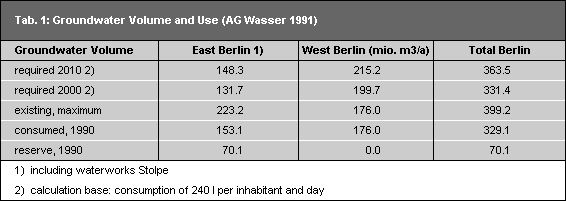The first groundwater aquifer is protected to varying degrees from contaminants by a geologic mantle of surface strata (natural protective effect). Cohesive soils are capable of absorbing a certain amount of pollutants by incorporating metals into their layer lattice of argillaceous minerals. These complexly bound pollutants in soils pose a relatively low danger to groundwater, but pollutants which are not bound can percolate (seep) into the groundwater.
A decomposition of pollutants in soil can occur by microbiological processes, but decomposition is substance-specific, and dependent on the nature, temperature, and oxygen content of the soil. But this self-purification, as well as the filtering effect, are relatively insignificant. Every further contamination presents a danger for the first groundwater aquifer. Sand and gravel without cohesive components bind only very small amounts of pollutants, and hardly protect groundwater. A "certain" protection is afforded only by a greater thickness (> 10 m), which prolongs percolation time.
Of importance for the temporal and spatial distribution of pollutants or groundwater are:
- overland flow and flow direction
- rate of infiltration and percolation and
- the horizontal flow velocity in the aquifer.
Overland flow occurs when
- the infiltration zone is composed of argillacaeous material such as clay, silt and/or boulder marl
- the surface has a gradient (slope)
- precipitation water exceeds the rate of infiltration.
Pollutants deposited in argillacaeous soil cannot infiltrate so quickly, but pollutants can be transported by rainwater into hollows with a sandy undersoil, and are also a great danger for the first groundwater aquifer.
The percolation rate or the water depth per unit of time is one of the critical criteria for groundwater vulnerability to pollution. This vulnerability derives primarily from the geologic structure of the mantle covering the groundwater (permeability, porosity) and its thickness (flow and percolation routes). An increase in argillaceous material is related to a decrease of the permeability co-efficient and thus the percolation rate. Greater depth increases the time needed for percolation.
The lithilogical (rock) structure of the groundwater aquifer and the groundwater flow gradient determine the horizontal flow rate and thus the temporal and spatial dispersion of pollutants within groundwater. A groundwater aquifer is not a homogeneous structure. Fine sand, coarse sand, or silt can alternate. For this reason a horizontal coefficient of permeability must be included to calculate flow velocity.
It is very difficult in practice to include every important influence on the vulnerability of groundwater to pollution into a model. Only the most important morphological and geological factors can be considered in preparing models and maps. No consideration can be given to the influences of physical-chemical characteristics of pollutants, or their interactions with the geological environment (such as geo-chemical coherence behavior).
The most important morphological and geological factors are considered to be:
- a terrain form line model (as a form line map, particularly for the evaluation of direction, velocity and volume of overland flow)
- a model of geological structures and the thickness of the mantle covering the first groundwater aquifer (as a differentiated map of vertical permeability coefficient)
- a model of groundwater dynamics (as a map of groundwater flow directions and velocities).
Initial attempts for preparing a hydrogeological model for Berlin are being developed by the Arbeitsgruppe Landesgeologie der Senatsverwaltung für Stadtentwicklung und Umweltschutz (Work Group for State Geology of the Berlin Department of Urban Development and Environmental Protection).
A detailed evaluation of the vulnerability of groundwater to pollution was not possible, due to the previously mentioned geological and morphological factors. A range of necessary statistical bases were either not available or their precision did not meet requirements.

